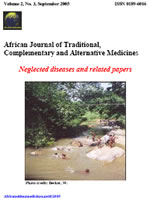
|
African Journal of Traditional, Complementary and Alternative Medicines
African Ethnomedicines Network
ISSN: 0189-6016
Vol. 14, No. 5, 2017, pp. 209-218
|
 Bioline Code: tc17074
Bioline Code: tc17074
Full paper language: English
Document type: Research Article
Document available free of charge
|
|
|
African Journal of Traditional, Complementary and Alternative Medicines, Vol. 14, No. 5, 2017, pp. 209-218
| en |
NOVEL APPLICATION OF CULTURED ROOTS OF MOUNTAIN GINSENG ( PANAX GINSENG  MEYER) AND GINSENOSIDE RE AS SAFE ANTIMELANOGENIC COSMECEUTICAL COMPONENTS MEYER) AND GINSENOSIDE RE AS SAFE ANTIMELANOGENIC COSMECEUTICAL COMPONENTS
Jiménez-Pérez, Zuly Elizabeth; Kim, Yeon-Ju; Castro-Aceituno, Veronica; Mathiyalagan, Ramya; Markus, Josua; Ahn, Sungeun; Simu, Shakina Yesmin & Yang, Deok-Chun
Abstract
Background: Mountain ginseng (Panax ginseng Meyer), which belongs to Araliaceae family, grows naturally in the
mountains of Korea. It is highly valued owing to its enhanced pharmacology effects such as immunostimulating,
antioxidant, anti-cancer and antiaging activity. An alternative to accessing the sparse mountain ginseng therapy benefits is
by tissue-cultured roots of mountain ginseng. The aim of this study is to evaluate the effect of water extract of cultured
roots of mountain ginseng (CRMG) and specifically its major compound ginsenoside Re (Re) on melanin synthesis in α-MSH-stimulated mouse melanoma B16BL6 cells (B16).
Materials and Methods: Cell cytotoxicity was evaluated trough a comparative study using normal human dermal
fibroblast (HDF) and B16. Then, α-MSH-stimulated B16 cells were analyzed, using melanin and tyrosinase activity assay.
Tyrosinase gene expression was evaluated trough reverse transcription polymerase chain reaction analysis and quantitative
PCR analysis. Finally, an in silico docking study was performed.
Results: The study demonstrated that CRMG and Re were non-toxic compounds and significantly reduced tyrosinase
activity and melanin content in B16 cells. Re decreased the mRNA expression of tyrosinase and other melanin synthesis-related
genes in B16 cells. In addition, in silico docking studies showed that Re had stronger interaction with tyrosinase
compared to control drug arbutin due to its higher binding affinity.
Conclusion: Taken together, our results suggest that CRMG and Re possess potential anti-melanogenic activities and may
be used as antimelanogenic cosmeceutical agents.
Keywords
Panax ginseng; cultured rood of mountain ginseng; ginsenoside Re; Tyrosinase; Docking.
|
| |
© Copyright 2017 - African Journal of Traditional, Complementary and Alternative Medicines
Alternative site location: http://journals.sfu.ca/africanem/index.php/ajtcam
|
|
